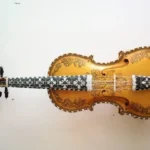
The trombone is a brass instrument, capable of producing sound that is rich and brilliant, lower than the French horn but not as low as the sound produced by a tuba. The trombone was developed from the trumpet common in the Medieval era and was documented in Ferrara court records in 1439. The Duke of Burgundy had a trombone player at his wedding in 1468. During the Renaissance and Baroque eras the trombone was referred to as a shakbusse or sackbut. It was lacking in some of the features of the modern trombone, but it had a double slide which allowed for lower scale sounds. The sackbut was the first musical instrument to have a moving slide.
The trombone has also been used to musically depict the depths of Hell in Mozart’s opera Don Giovanni, the chopping off of a head in Richard Strauss’ Till Eulenspiegel, thunder and lightning in Beethoven’s Pastoral Symphony, and the raucous crowd anticipating and delighting in a beheading in Berlioz Symphonie Fantastique.
The word ‘trombone’ is derived from the Italian word ‘tromba’ which means ‘trumpet’, and ‘one’ which means ‘big’. Together they formed the word ‘trombone’ which means ‘big trumpet’.
Trombonists are often asked to count a large amount rests or simply wait until the end of a symphony or opera before they get to play.
The trombone’s body includes a mouthpiece, first brace, second brace, slide, water key, tuning slide, and bell.
All southpaw trombone players who are left hand dominant are forced by the constraints of the trombone to be right hand dominant.
Most brass instruments rely on valves to create varying pitches but the trombone relies on the slide. The slide replaces the valves in other brass instruments, which use valves to select tubing length.
Trombonists often use a plunger mute in jazz to achieve the effect of a human voice speaking.
When the trombone player moves the slide out the note is lower and when the trombone player pulls the slide toward them the note is higher.
The first documented use of a trombone in public was a wedding gig.
The first composer to create a symphony trombone part was Beethoven who included it in his famous “Fifth Symphony”.
The earliest record of a trombone dates to the 15th century.
The trombone is a popular instrument to portray dark moments in operas such as “Don Giovanni” (by Mozart), or “Till Eulenspiegel” (by Richard Stauss).
The trombone uses a slide to alter pitches, rather than a valve. It is the only instrument in the brass family to do so!
Left-handed trombone players must learn to play with their right hand being dominant because of its design. Some of the most famous trombone players were left-handed.
The trombone has been called multiple names, including dracht (draught, draucht) trumpet and tuba ductilis.
Trombones are versatile instruments and are commonly found in jazz bands, marching bands, and orchestras. They are also found in brass choirs, brass bands, military bands, swing music, salsa music, R&B music, and merengue music.
Trumpets were featured in various paintings, images, and diagrams since the 15th century. The first visual of a trombone was in Filippino Lippi’s fresco The Assumption of the Virgin in S Maria sopra Minerva, Rome in 1488-93.
Eric McGavin invented a one-handed trombone that featured a double slide.
The first diagrammatic depiction of a trombone is Aurelio Virgiliano’s Il dolcimelo (1600).
There are different types of trombones including the bass trombone, the tenor trombone, the contrabass trombone, the soprano trombone, the treble cleff trombone, and the alto trombone.
The oldest surviving trombone was made in 1551.
In 2012, 360 trombone players played 76 trombones around Washington’s national baseball field, making it the largest trombone ensemble.
One of the most notable early mouthpieces is embellished with the mark of the Schnitzer family, who made trombones in Nuremberg in the 16th century.
Paul Newman, Nelly Furtado, Tommy Dorsey, Slide Hampton, Trombone Shorty, and Jonathan Frakes are a few of the most famous trombone players.
It was not until the late 18th century that the trombone became an official part of the orchestra.
The cartoon characters Homer Simpson (The Simpsons) and Peter Griffin (Family Guy) play the trombone.
German trombones from the late 19th and the early 20th centuries often carried a traditional mark of a pair of snakes dancing across the bell bow. These snakes are called, “Schlangenverzierungen.”
Jean Chretien, Canada’s former Prime Minister, plays the trombone.
The trombone is rarely heard as a solo instrument, apart from in some jazz music.
Famous composers who included the trombone in their works include George Gershwin, Leonard Bernstein, Igor Stravinsky, Gustav Holst, Sergei Prokofiev, and Arnold Shoenberg.
There are just a few notable trombone soloists, however, predominantly form the 19th century.
When the teacher in the Charlie Brown cartoons speaks, her voice is the sound of a trombone.
The group including C.T. Queisser and F.A. Belcke in Germany, and in France, A.G. Dieppo.
Sigmund Freud said that the trombone made him uncomfortable and Mark Twain was not a fan of the instrument either, referring to it as ‘unholy trombone’, and referring to the music it produces as ‘wretched music’ with ‘discordant sounds’.









